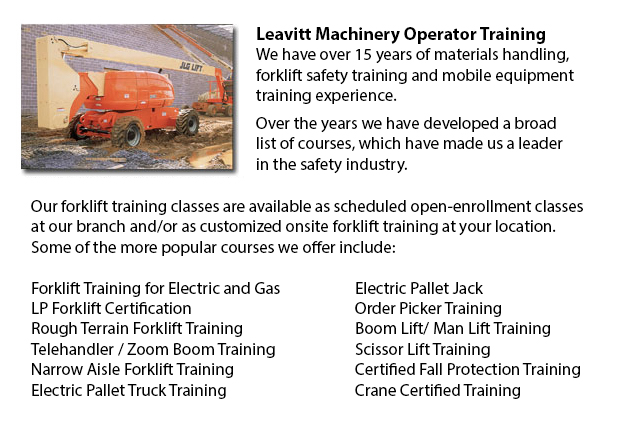
Saskatoon Boom Lift Safey Training - Boom lifts are a kind of elevated work platform or aerial lifting device which are usually utilized in industry, warehousing and construction. Boom lifts can be used in practically whichever setting because of their versatility.
Elevated work platforms allow workers to get into work places which would be inaccessible otherwise. There is inherent risk in the operation of these devices. Employees who operate them must be trained in the proper operating techniques. Preventing accidents is vital.
The safety factors that are involved in using boom lifts are covered in our Boom Lift Training Programs. The course is best for those who operate self-propelled elevated work platforms and self-propelled boom supported elevated work platforms. Upon successful completion of the course, participants would be issued a certificate by a person who is licensed to verify the completion of a hands-on assessment.
In order to help train operators in the safe utilization of elevated work platforms, industry agencies, federal and local regulators, and lift manufacturers all play a role in establishing standards and providing the necessary information. The most important ways in preventing accidents connected to the utilization of elevated work platforms are the following: putting on safety gear, performing site assessment and inspecting equipment.
Important safety factors when operating Boom lifts:
Operators stay away from power line, observing the minimum safe approach distance (or also known as MSAD). Voltage could arc across the air to find an easy path to ground.
To be able to maintain stability as the platform nears the ground, a telescopic boom should be retracted prior to lowering a work platform.
People working from the Boom lift platform should tie off to be able to ensure their safety. lanyard and safety harness combinations should not be connected to any anchorage other than that provided by the manufacturer, never to other poles or wires. Tying off may or may not be necessary in scissor lifts, which depends on specific local rules, employer guidelines or job risks.
Avoid working on a slope which exceeds the maximum slope rating as specified by the manufacturer. If the slop exceeds requirements, therefore the equipment must be winched or transported over the slope. A grade could be measured simply by laying a minimum 3-feet long straight board or edge on the slope. Next a carpenter's level can be laid on the straight edge and raising the end until it is level. The per-cent slope is obtained by measuring the distance to the ground (also referred to as the rise) and dividing the rise by the length of the straight edge. Next multiply by one hundred.
-
Saskatoon Telehandler License
Saskatoon Telehandler License - The telescopic handler or telehandler is a frequently utilized machine in agricultural and industrial applications. This particular equipment is similar in appearance to a forklift and even functions in a similar way,... More -
Saskatoon Zoom Boom Ticket
Saskatoon Zoom Boom Ticket - Zoom Boom Training focuses on correctly training prospective operators on variable reach forklifts. The training objectives consist of gaining the knowledge of the machine's physics and to define the job of the operator.... More -
Saskatoon Forklift Operator Training
Saskatoon Forklift Operator Training - In North America, lift truck operator training is needed in order to prevent workplace injuries and accidents. Particular lift truck training will be provided to offer forklift operators driver training. The saf... More -
Saskatoon Forklift Certification Schools
Saskatoon Forklift Certification Schools - Forklift Certification is mandatory in North America. Hence, forklift training programs are essential both for businesses and for individuals seeking jobs in industries as forklift operators. Forklift traini... More -
Saskatoon Telehandler Training Courses
Saskatoon Telehandler Training Courses - Employers are responsible for making certain that their operating personnel and supervisors are trained to work competently utilizing telehandler machines. The competence level of staff must be assessed. If de... More -
Saskatoon Boom Lift Training
Saskatoon Boom Lift Training - Aerial platforms or likewise known as elevated work platforms are devices that enable workers to perform tasks and duties at elevated heights that will not be otherwise accessible. There are many aerial lifts available... More -
Crane / Overhead Crane / Self-Erect Crane / Truck Mounted Crane / Hydraulic Cranes Training in Saskatoon
Overhead cranes are likewise referred to as bridge cranes. They are a type of crane which comprises a line and hook device that runs along a horizontal beam which runs along two widely separated rails. Several overhead cranes can be found within a lo... More -
Saskatoon Heavy Equipment Training Programs
Saskatoon Heavy Equipment Training Programs - At any given construction site, there are usually different types of machinery which are ready to be used. These light and heavy machinery require both operators to run them and mechanics to fix them. Tra... More

Forklift Certification Saskatoon
TOLL FREE: 1-888-254-6157
Saskatoon, Saskatchewan
forkliftcertificationsaskatoon.com
Email Us
About Us


